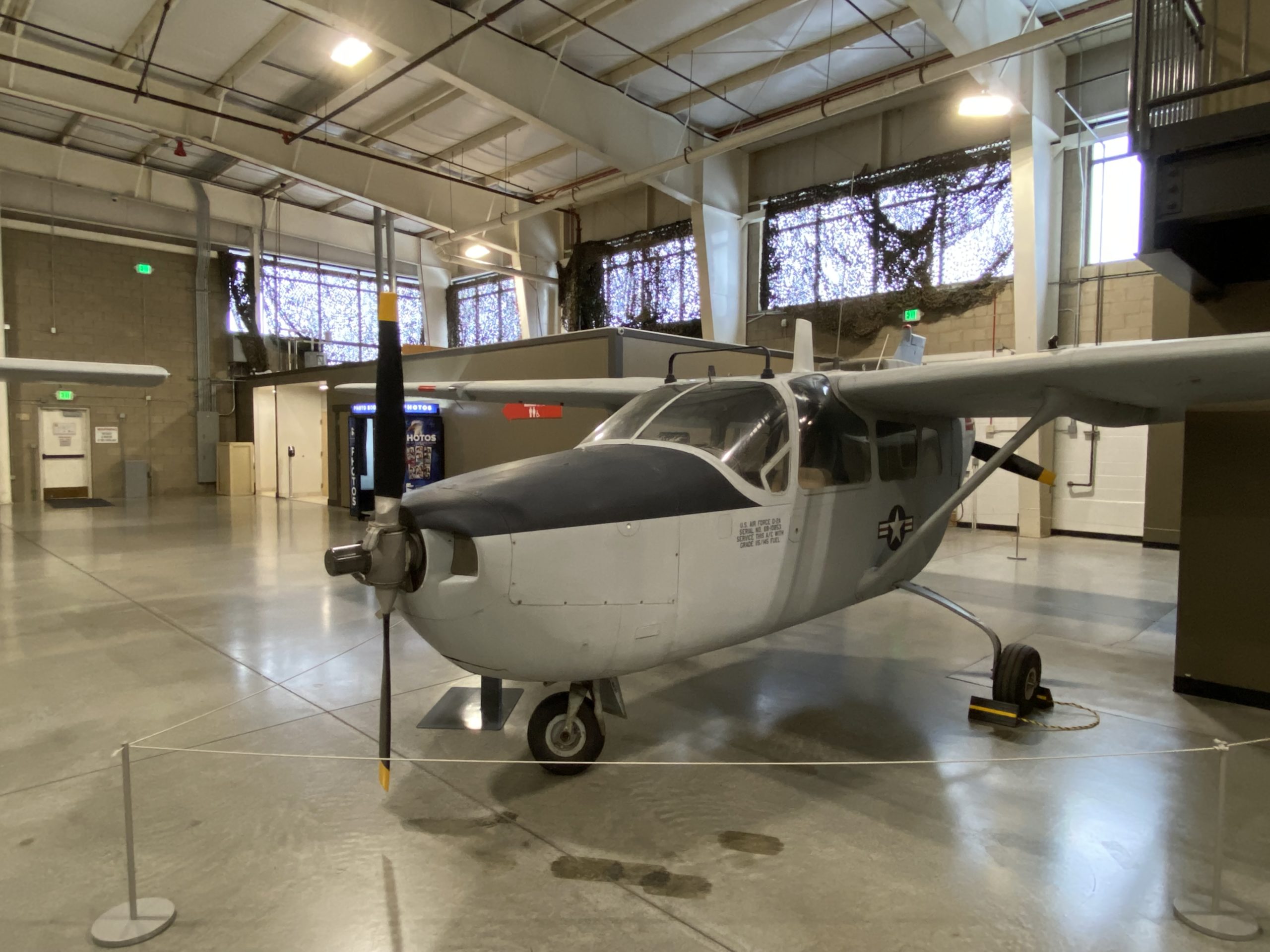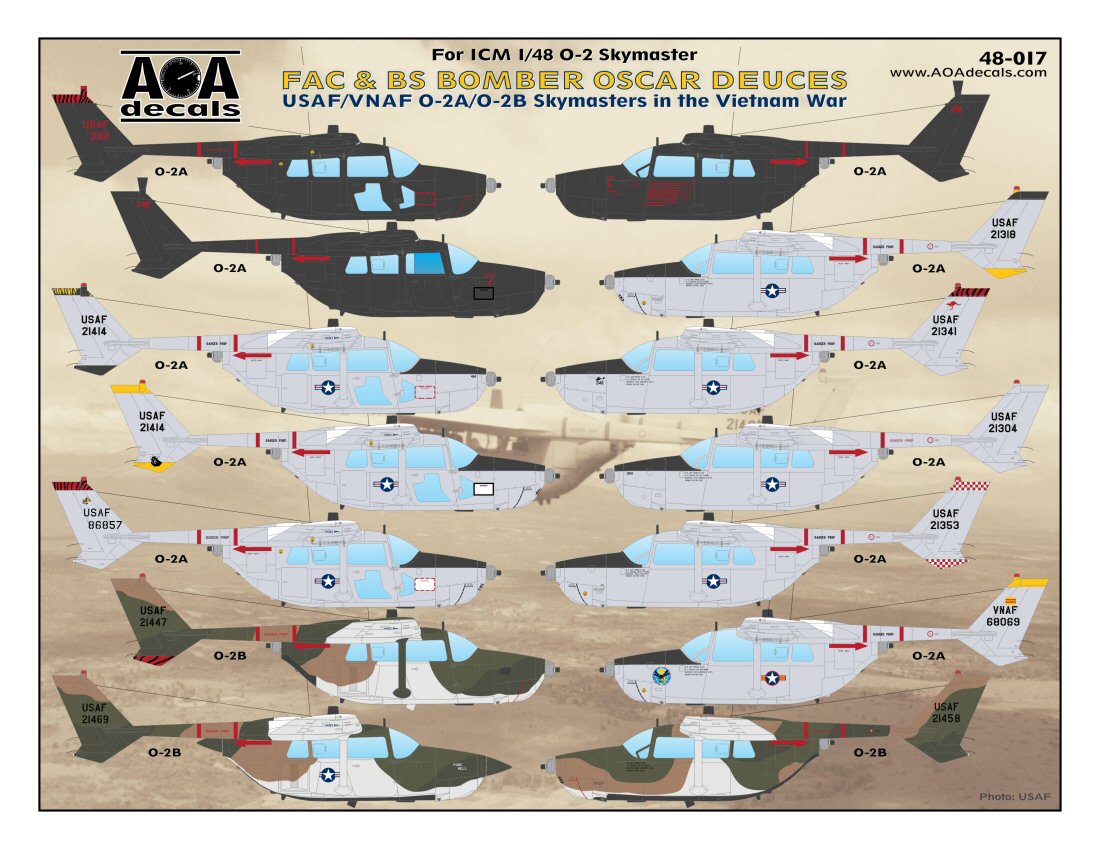O 2 Aircraft - During the 1920s and early 1930s, the Douglas observation biplanes were among the most important American military aircraft. During the 1934 airmail emergency, when President Franklin Roosevelt directed the Army Air Corps to take over from private contractors because of suspected improprieties in awarding contracts, Douglas biplanes flew the U.S.
airmail routes for 78 days. Between 1923 and 1936, the company sold 879 in the series, one as a civil aircraft, 108 to foreign air forces and 770 to the U.S. military services. After service in Vietnam, the museum's 0-2B,
O 2 Aircraft

serial number 67-21465, was assigned to the Military Aircraft Storage and Disposition Center (MASDC) at Davis-Monthan Air Force Base, Arizona. In October 1973, 67-21465 was re-called to active duty to fly with the 163rd Tactical Air Support Group of the California Air National Guard.
Cal Fire
In 1975, the 163rd moved to March Air Force Base. By 1982, 0-2B 21465 was fully retired from the United States Air Force with a total of 4,696 flight hours, and a bad case of metal fatigue.
In 2000, 0-2B 67-21465 was brought to the museum. This aircraft is on loan from the NMUSAF The first O-2 flew in January 1967 and the plane went into production shortly thereafter, with the USAF taking delivery in March 1967. A total of 532 O-2s were built in two variants for the USAF by 1970. The O-2A served

as a FAC aircraft with the 20th Tactical Air Support Squadron, while the O-2B was equipped with loudspeakers and a leaflet dispenser for use in the psychological operations (PSYOPS) role. Several USAF O-2 aircraft were later transferred to and operated by the former VNAF South Vietnamese Air Force.[3]
The great advantage of the front and back engine arrangement was in not having to compensate for off-center thrust should one of the engines go out. Originally, Cessna intended this feature as an aid to pilots who were transitioning from single to twin engine aircraft.
O- Skymaster
In tactical operations this arrangement provided a margin of safety not otherwise attainable. Having twin engines enabled the O-2 to absorb more ground fire and still return safely, endearing it to its crew. Douglas designed his first experimental observation aircraft, the XO-2, in 1923 and delivered 45 of the first production version, the O-2.
On Feb. 16, 1925, a contract was signed for 75 of the O-2 type, the largest single contract in terms of production units the company had yet received. Skymasters were widely used for reconnaissance, target identification, damage assessment and air-to-ground coordination.

Several O-2 aircraft were equipped with three 600-watt amplified speakers and leaflet pods for psychological warfare operations. In-service modifications gave some O-2s the capability to carry light weapons, such as rockets, bombs and mini-guns. When used as either a Forward Air Controller or as a Propaganda Broadcast aircraft, the O-2 spent most of its time flying above tree tops.
As a Forward Air Controller the O-2 was responsible for visual reconnaissance, target identification, target marking, ground to air coordination and damage assessment. In 1967, the Air Force completed an exhaustive search for an improved observation aircraft to replace the aging O-1 aircraft used by forward air controllers in Vietnam.
The Savior
Already on the production line, the Cessna 337 Super-Skymaster was a popular twin-engine, four-seat general aviation aircraft with a unique push-pull design. Engines mounted on the forward and rear of the fuselage gave the C-337 the extra power and reliability of two engines
while retaining the advantage of centerline thrust and a high wing, making it an excellent platform for observation missions. Minor alterations, the installation of a gunsight, under-wing pylons, a smoke generator; glass panels in the lower starboard door and a loudspeaker for psychological warfare and the C-337 was transformed into the inexpensive and versatile O-2 Skymaster.

In late 1966, the USAF selected a military variant, designated O-2, to supplement the O-1 Bird Dog forward air controller (FAC) aircraft then operating in Southeast Asia. The O-2 first flew in Jan. 1967 and production deliveries began in March.
Production ended in June 1970 after 532 O-2s had been built for the USAF. An O-2BS, made for pilot James Dalzell McKee, after whom the Canadian aviation McKee Trophy is named, made the first single-aircraft, single-pilot flight across Canada.
Design And Development
Because of the many Canadian rivers and lakes, twin floats were installed on the landplane. Between Sept. 11 and 19, 1926, McKee flew the 3,000 miles (4,828 kilometers) between Montreal and Vancouver, British Columbia, in 35 hours, 8 minutes, at an average speed of 85 mph (136 kph).
The plane later was modified as a three-seater and used by the Canadian government until January 1930 as a high-altitude photographic survey aircraft. The museum's 0-2B serial number 67-21465, was manufactured by Cessna Aircraft, Wichita, KS, and delivered to the USAF on January 18, 1967. It was the 26th 0-2B off the assembly line out of only 31 produced.
Aircraft 67-21465 was used for psychological warfare operations, dropping leaflets with many different messages, some instructional, but mostly warnings of impeding defoliation flights or exhortations to enemy troops to lay down their arms. It was also equipped with a 300lb 1800 watt amplified speaker system.
Easy targets, the O-2s engaged in psychological warfare operations were frequent targets for enemy ground fire. Of the six USN aircraft mentioned above, two were transferred to the U.S. Army in late 1990.[4] O-2As had originally entered the U.S.
Army's inventory in 1967 from USAF stocks and were augmented by the 1990 aircraft transfer from the U.S. Navy. Several disassembled USAF O-2s remain in storage at Davis-Monthan AFB, Arizona.[4] Two O-2As were used at Laguna Army Airfield, Arizona as part of testing programs carried out by the Yuma Proving Ground.
These were retired in October 2010 and sent to a museum.[1] During the Salvadoran Civil War the Salvadoran Air Force received a total of 23 O-2As and 2 O-2Bs from the United States, the first arriving in 1981. The O-2s were employed to observe the movements of FMLN formations and direct air strikes

against them, playing a major role in forcing the rebel movement to abandon large-scale operations. Near the end of the war in 1990, the rebel's acquisition of SA-7 missiles resulted in the loss of two O-2As, while another was destroyed by mortar fire, and two more were lost in crashes.[6]
As with the civilian version, the Skymaster was a low-cost twin-engine piston-powered aircraft, with one engine in the nose of the aircraft and a second engine in the rear of the fuselage. The push-pull configuration meant a simpler single-engine operating procedure due to centerline thrust compared to the common low-wing mounting of most twin engine light planes, and also allowed for a high wing, providing clear observation below and behind the aircraft.
During the Vietnam War, the Skymaster was intended to be replaced in the forward air control (FAC) mission by the OV-10 Bronco, but the O-2A maintained a night mission role after the OV-10's introduction due to the OV-10's
high level of cockpit illumination, rendering night reconnaissance impractical.[1] The O-2 was phased out completely after additional OV-10 night upgrades.[2][3] Two series were produced: the O-2A and the O-2B. the O-2A was equipped with wing pylons to carry rockets, flares, and other light ordnance.
In the FAC role the O-2A was used for identifying and marking enemy targets with smoke rockets, coordinating air strikes and reporting target damage. The O-2B was a psychological warfare aircraft equipped with loudspeakers and leaflet dispensers.
It carried no ordnance. The Douglas O-2 observation biplane had longer wings, had lower landing speeds, flew higher and was 22 mph (35 kph) faster than its competitors. The O-2, produced for the U.S. Army Air Service, was the first of a series that remained in production for nine years.
The O-2 Skymaster (also known as the "Oscar Deuce" or "The Duck") is a military version of the Cessna 337 Super Skymaster utilized as an observation and forward air control (FAC) aircraft. The United States Air Force commissioned Cessna to build a military variant to replace the O-1 Bird Dog in 1966.
o 2 skymaster in vietnam, cessna o 2 skymaster, o2 cessna, air force o2 aircraft, 0 2 aircraft, o 2 skymaster, cessna o 2, cessna 02 skymaster vietnam